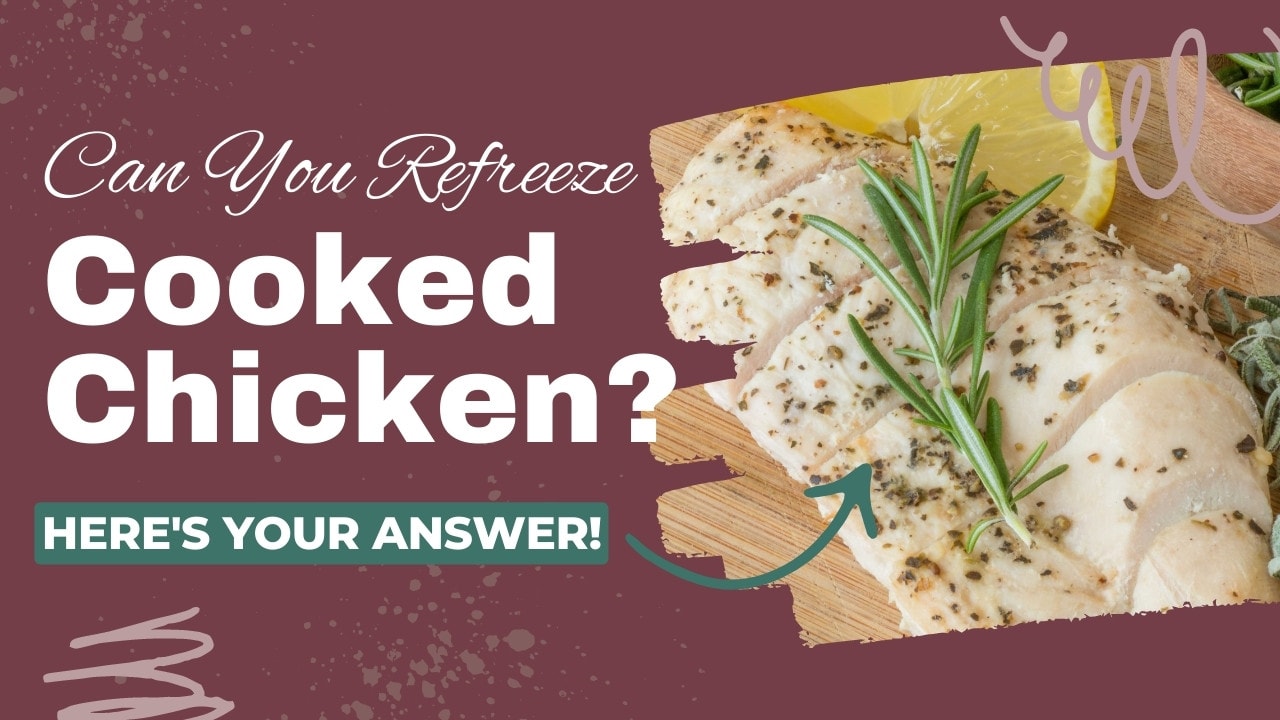Discover the secrets behind safely thawing chicken and uncover the truth about refreezing it.
Can you refreeze chicken?
Let’s explore the different methods of thawing, from refrigerator to microwave to cold water.
Dive into this culinary dilemma and learn the best way to handle your poultry while keeping it deliciously safe.
can you refreeze chicken
Yes, you can refreeze chicken, but only if it has been thawed in the refrigerator.
Chicken that has been thawed in the microwave or in cold water must be cooked before it can be refrozen.
Thawing chicken in the microwave may cause uneven cooking, making it unsafe to refreeze without fully cooking it.
Similarly, thawing chicken in cold water requires cooking before refreezing, as maintaining a consistently cold temperature is difficult.
It is important to cook chicken to a minimum internal temperature of 165°F.
In summary, chicken can be refrozen, but only if it has been thawed in the refrigerator or cooked thoroughly after being thawed by other methods.
Key Points:
- Chicken can be refrozen if it has been thawed in the refrigerator.
- Chicken that has been thawed in the microwave or in cold water must be cooked before refreezing.
- Thawing chicken in the microwave may cause uneven cooking, making it unsafe to refreeze without fully cooking it.
- Thawing chicken in cold water requires cooking before refreezing due to difficulty maintaining a consistently cold temperature.
- Chicken should be cooked to a minimum internal temperature of 165°F.
- In summary, chicken can be refrozen if it has been thawed in the refrigerator or cooked thoroughly after being thawed by other methods.
can you refreeze chicken – Watch Video
💡
Pro Tips:
1. Refreezing chicken is safe as long as you have thawed it properly in the refrigerator, but the texture may become slightly dry due to moisture loss.
2. When refreezing chicken, it’s important to note that the quality and taste of the meat can be affected, as freezing and thawing can cause cellular damage, leading to a change in flavor.
3. Once cooked, you can safely refreeze chicken. This means that if you have leftover cooked chicken, you can freeze it again for later use without any concerns.
4. It is recommended to refreeze raw chicken within two days of thawing it in the refrigerator to maintain maximum freshness and reduce the risk of bacterial growth.
5. The process of refreezing chicken needs to be done quickly to minimize the time the meat spends at warmer temperatures, as this can allow bacteria to multiply. It is best to avoid refreezing chicken multiple times to ensure food safety.
Various Ways To Thaw Chicken
When it comes to thawing chicken, there are a few methods that can be used. The most recommended option is to thaw chicken in the refrigerator, as it ensures a safe and even thaw. However, if you’re short on time, you can also use the microwave or cold water to thaw the chicken.
Thawing chicken in the refrigerator is the best option, although it takes one to two days. This method allows the chicken to thaw at a consistent and safe temperature, which helps maintain its quality and texture. It is important to note that the chicken should be placed in a leak-proof plastic bag or container to prevent any cross-contamination.
If you’re in a hurry and need to thaw the chicken more quickly, you can use the microwave. However, keep in mind that if you choose this method, it is crucial to cook the chicken immediately after thawing it, as parts of the chicken may warm and start cooking during the process. Thawing chicken in the microwave should be done with caution to avoid any foodborne illnesses.
Another quick thawing method is using cold water. To do this, place the chicken in a leak-proof plastic bag and submerge it in cold water. Change the water every 30 minutes to maintain its cold temperature. Similar to thawing in the microwave, chicken thawed in cold water should be cooked immediately after thawing to ensure its safety.
Thawing Chicken In The Refrigerator
Thawing chicken in the refrigerator is the most ideal method, although it requires some patience. This method ensures that the chicken thaws at a safe and steady temperature, minimizing the risk of bacterial growth. It is recommended to plan ahead and allow one to two days for the chicken to fully thaw in the refrigerator.
To thaw chicken in the refrigerator, follow these steps:
- Place the chicken on a plate or in a container to catch any drips.
- Properly seal the chicken in a leak-proof plastic bag or container to prevent any cross-contamination with other foods.
- Put the chicken in the coldest part of the refrigerator, such as the bottom shelf.
By thawing chicken in the refrigerator, you can rest assured that it will maintain its quality, taste, and texture. Additionally, this method allows for easy refreezing of the chicken if needed.
Refreezing Chicken Thawed In The Refrigerator
If you have thawed chicken in the refrigerator and it remains within the recommended two-day window, you can safely refreeze it without any concerns. Thawing chicken in the refrigerator keeps it at a consistently low temperature, preventing any bacterial growth that could lead to foodborne illnesses.
To refreeze the chicken, make sure it is properly sealed in an airtight container or freezer bag. Label the container with the date of thawing to keep track of its freshness. It’s important to note that refreezing chicken can affect its taste and texture, so it’s best to use it within a reasonable timeframe to maintain its quality.
The Need To Cook Chicken Thawed In The Microwave Or Cold Water Before Refreezing
When thawing chicken, it is crucial to note that chicken thawed in the refrigerator is safe to refreeze as is. However, the same cannot be said for chicken that has been thawed in the microwave or cold water. In such cases, it must be cooked before refreezing to ensure its safety.
The reason behind this precaution is that thawing methods like the microwave or cold water may cause certain parts of the chicken to warm up and even start cooking during the process. Consequently, if the chicken is only partially cooked, it creates a breeding ground for bacteria and increases the risk of foodborne illnesses.
Therefore, if you choose to thaw chicken using the microwave or cold water, it is absolutely necessary to cook it immediately after thawing. Only once it has been fully cooked to a safe internal temperature should you consider refreezing it for later use.
To summarize:
- Chicken thawed in the refrigerator can be refrozen as is.
- Chicken thawed in the microwave or cold water must be cooked before refreezing.
- Partially cooked chicken can lead to the growth of bacteria and foodborne illnesses.
- Thawed chicken should be cooked immediately after thawing.
- Only refreeze chicken after it has been fully cooked to a safe internal temperature.
“Thawing chicken in the microwave or cold water requires immediate cooking before refreezing to prevent bacterial growth.”
Risks Of Partially Cooking Chicken During Microwave Thawing
Thawing chicken in the microwave can be a quick solution when time is limited. However, there are risks associated with partially cooking the chicken during this process.
Microwaves heat food unevenly, and during the thawing process, some parts of the chicken may become warm or partially cooked, while others remain frozen. This uneven cooking increases the risk of bacterial growth and foodborne illnesses if the chicken is not fully cooked before refreezing.
Therefore, it is crucial to ensure that chicken thawed in the microwave is immediately cooked to a safe internal temperature to eliminate any potential health risks.
Difficulty Of Maintaining Consistent Cold Temperature During Cold Water Thawing
Cold water thawing is a quick method to thaw frozen chicken. However, maintaining a consistently cold temperature throughout the process can be challenging, which makes it necessary to cook the chicken before refreezing.
When using the cold water method, the chicken should be placed in a leak-proof plastic bag and submerged in cold water. It is important to change the water every 30 minutes to maintain a cold temperature. But even with this precaution, it is difficult to guarantee a consistent and low temperature, increasing the risk of bacterial growth.
Therefore, it is recommended to cook chicken thawed using the cold water method immediately to eliminate any potential food safety issues before refreezing.
- Place the chicken in a leak-proof plastic bag.
- Submerge the bag in cold water.
- Change the water every 30 minutes.
- Cook the chicken immediately after thawing to ensure food safety.
“Maintaining a consistently cold temperature is essential when using the cold water thawing method.”
Minimum Internal Temperature For Cooking Chicken
Regardless of the thawing method used, it is essential to cook chicken to a minimum internal temperature of 165°F (74°C). This temperature is considered safe to kill any harmful bacteria that may be present in the chicken.
Using a food thermometer is the most accurate way to ensure the chicken reaches the appropriate temperature. Insert the thermometer into the thickest part of the chicken without touching the bone, and once it reaches 165°F (74°C), the chicken is safe to consume.
It is important to note that undercooked chicken can harbor harmful bacteria, while overcooked chicken can result in a loss of flavor and tenderness. Therefore, using a food thermometer is a reliable method to achieve the ideal internal temperature and ensure both food safety and taste.
- Thaw the chicken properly before cooking.
- Use a food thermometer to check the internal temperature.
- Avoid overcooking to maintain flavor and tenderness.
“Using a food thermometer is a reliable method to achieve the ideal internal temperature and ensure both food safety and taste.”
The Ability To Refreeze Chicken After Cooking
After properly cooking chicken, it is safe to refreeze it if needed. The key factor is to ensure the chicken reaches the minimum internal temperature of 165°F (74°C) before refreezing.
Properly cooked chicken reduces the risk of bacterial growth and ensures its safety and quality during the freezing and thawing process. Cooked chicken can be stored in airtight containers or freezer bags, labeled with the date of cooking, and kept in the freezer for future use.
It is worth mentioning, however, that each time chicken is thawed and refrozen, its quality may deteriorate. Therefore, it is best to use previously frozen and refrozen chicken within a reasonable timeframe to maintain its texture, taste, and overall quality.
The Importance Of Cooking Chicken Before Refreezing
Cooking chicken before refreezing it is crucial to eliminate any potential health risks associated with partially cooked chicken that has been thawed using the microwave or cold water methods.
When chicken is partially cooked during the thawing process, bacteria can thrive and multiply, leading to foodborne illnesses if the chicken is not fully cooked before refreezing. Cooking the chicken to the appropriate internal temperature ensures that any harmful bacteria are eliminated, making it safe for consumption after refreezing.
By taking the time to cook chicken before refreezing, you are prioritizing food safety and reducing the risk of illness from consuming improperly thawed and refrozen chicken.
Final Verdict: Refreezing Chicken With Proper Precautions
It is possible to refreeze chicken, but it must be done with proper precautions to ensure both food safety and taste. Thawing chicken in the refrigerator is the recommended method, as it allows for a slow and consistent thaw.
If chicken is thawed using the microwave or cold water, it must be cooked to a minimum internal temperature of 165°F (74°C) before being refrozen. Partially cooked chicken from these thawing methods can lead to bacterial growth and foodborne illnesses if not fully cooked.
Refreezing chicken should be done promptly and in airtight containers or freezer bags to maintain its quality. However, the taste and texture of chicken may be affected each time it is thawed and refrozen, so it is best to use it within a reasonable timeframe.
“By following these guidelines and prioritizing food safety, you can refreeze chicken without compromising its taste, ensuring a delicious and safe meal for you and your loved ones.”
- Thaw chicken in the refrigerator for slow and consistent results
- Microwave or cold water thawing requires cooking to a minimum internal temperature of 165°F (74°C)
- Promptly refreeze chicken in airtight containers or freezer bags
- Use thawed and refrozen chicken within a reasonable timeframe to maintain taste and texture.
💡
You may need to know these questions about can you refreeze chicken
Why can’t you refreeze chicken?
Once chicken has been thawed and left out longer than two days, or if it has been cooked and stored for more than four days, there is a higher chance of spoilage. Refreezing this chicken could further contribute to the growth of bacteria and the deterioration of its quality. Therefore, it is recommended not to refreeze chicken that falls into these categories. To ensure the chicken’s freshness, it should be stored at or below 0°F (-18°C) right from the beginning and throughout its storage period.
Why can’t you freeze meat twice?
Freezing meat twice can negatively impact its quality due to the effects of thawing and refreezing. When meat is thawed, it undergoes changes that can affect its color, odor, moisture content, and fat and protein oxidation. These changes become more pronounced with each freeze-thaw cycle. Therefore, it is recommended not to freeze meat multiple times to maintain its optimal quality for consumption.
How many times can meat be refrozen?
Williams, a food safety expert. This is because each thawing and refreezing cycle causes moisture loss, which can impact the texture and flavor of the meat. Therefore, while you technically can refreeze meat multiple times, it is generally recommended to avoid excessive refreezing and aim to use it within one or two cycles for optimal taste and quality.
Can you refreeze something that has been thawed?
Yes, it is possible to refreeze something that has been thawed as long as proper precautions are taken. While there may be a slight loss in quality due to the moisture lost during the thawing process, it can still be safely refrozen. However, it is important to note that the thawed food should have been kept at a temperature of 40 degrees or below and should not have been left out for more than 3-4 days in order to maintain food safety standards.
Reference source
https://www.eatingwell.com/article/7959364/can-you-refreeze-chicken/
https://www.healthline.com/nutrition/can-you-refreeze-chicken
https://www.healthline.com/nutrition/can-you-refreeze-meat
https://www.consumerreports.org/health/food-safety/smarter-how-many-times-can-you-thaw-and-refreeze-meat-a1713781847/



